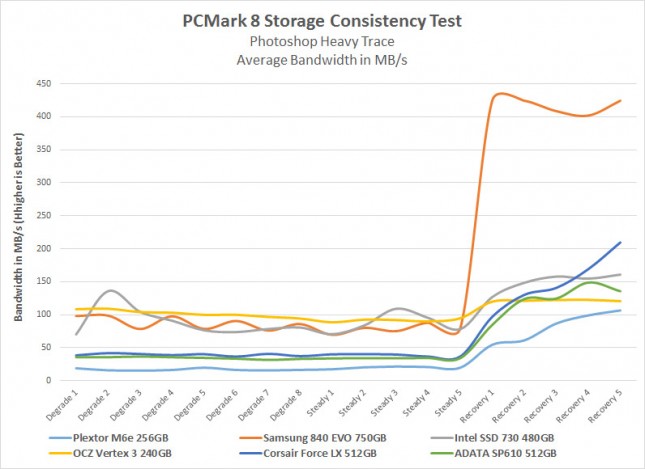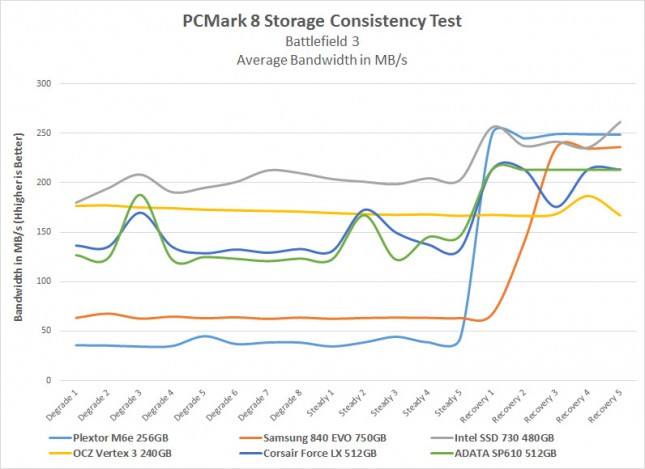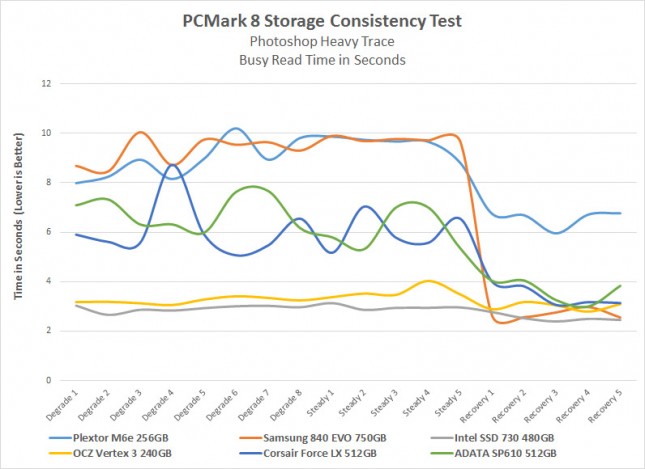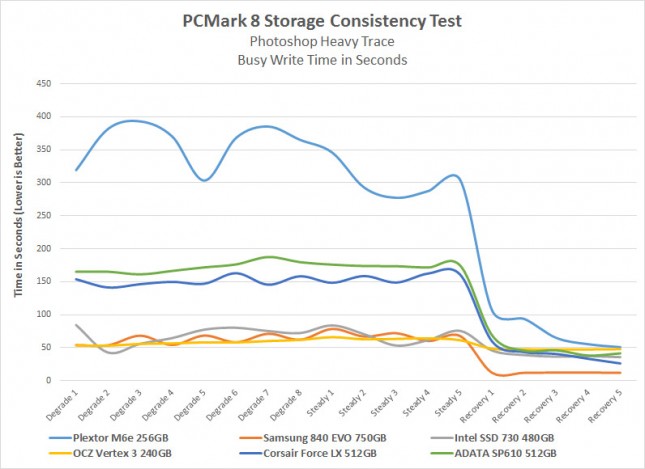SSD Review – ADATA SP610 512GB Versus Corsair Force LX 512GB
PCMark 8 Consistency Test
Something new we are starting to do is run the storage consistency test in the PCMark 8 application from Futuremark. In short, it looks at drive performance degradation as the drive becomes “dirty” and how it rebounds after given time to recover and run background routines like garbage collection and TRIM. This takes nearly a day to run through all of the iterations of test sets. Since most of our benchmarks show the drive performance in a clean state, this is a nice contrast to provide yet another view of performance. PCMark 8’s storage benchmark test contains workload traces from Adobe Photoshop, Adobe Illustrator, Adobe InDesign, Adobe After Effects, Microsoft Word, Microsoft Excel, Microsoft Power Point, World of Warcraft and Battlefield 3.
The PCMark 8 Consistency test has five phases:
Precondition phase
- Write the drive sequentially through up to the reported capacity with random data.
- Write it through a second time (to take care of overprovisioning).
Degradation phase
- Run writes of random size between 8*512 and 2048*512 bytes on random offsets for 10 minutes.
- Run performance test (one pass only). The result is stored in secondary results with name prefix degrade_result_X where X is a counter.
- Repeat 1 and 2 for 8 times and on each pass increase the duration of random writes by 5 minutes
Steady state phase
- Run writes of random size between 8*512 and 2048*512 bytes on random offsets for final duration achieved in degradation phase.
- Run performance test (one pass only). The result is stored in secondary results with name prefix steady_result_X where X is a counter.
- Repeat 1 and 2 for 5 times.
Recovery phase
- Idle for 5 minutes.
- Run performance test (one pass only). The result is stored in secondary result with name recovery_result_X where X is a counter.
- Repeat 1 and 2 for 5 times.
Clean up
- Write the drive sequentially through up to the reported capacity with zero data.
Benchmark Results: There is a pretty significant difference between rives when it comes to performance in a optimized TRIM state versus a heavily used state without the time needed to execute the TRIM command. The chart above looks at the Photoshop Heavy Trace test scenario. The Corsair Force LX 512GB and ADATA SP610 512GB drives basically mirrored one another until the recovery stages where the Corsair Force LX 512GB did slightly better. In the final recover test there was a 70MB/s difference between the two drives, which is more higher than expected, so it could be an anomaly. The Force LX and SP610 don’t perform as well as some of the higher-end drives in the worst-case dirty states, but come very close to being able to hang with the Intel SSD 730 480GB drive when given time to recover. The OCZ Vertex 3 240GB SSD was once a flagship SSD only a couple years ago and you can see in a recovered state that a budget SSD is able to perform with yesteryear’s flagship drive.
Benchmark Results: Gaming is a big deal to many of our readers, so here is a look at the detailed Battlefield 3 test results, which are clearly different than what we saw with Photoshop Heavy Trace. The Plextor M6e M.2 PCIe drive is the fastest on paper, but it performed the worst in a degraded state and the best of all the drives when recovered. The Samsung 840 EVO 750GB drive went from doing great in a degraded state and the best in a recovered state went to the second worst in a degraded state and third best in a recovered state. The Corsair Force LX 512GB and ADATA Premier SP610 were again very similar and were right in the middle of the pack. The Intel SSD 730 480GB is the stand out drive though as there was very little performance difference between a dirty state and a recovered state.
Benchmark Results: This chart looks at the total busy time that the drives are doing the read test in the Photoshop Heavy Trace workload. The lower the time the better and you can see the Intel SSD 730 480GB does the best when it comes to this specific workload with the older OCZ Vertex 3 240GB SSD not too far behind. The Samsung 840 Evo struggles with Busy Read times and was slower than we expected it to be. The Plextor M6e 256GB drive doesn’t do that hot, but we know Plextor is coming out with a new firmware this month to fix some ‘issues’ many review sites have found when doing benchmarking like this. The ADATA SP610 512GB and Corsair Force LX 512GB drives have respectable busy read times for budget drives.
Benchmark Results: This chart looks at the total busy time that the drives are doing the write test in the Photoshop Heavy Trace workload. The lower the time the better and you can see the Plextor M6e 256GB SSD is having some serious issues in a dirty degraded state as takes close to 400 seconds of time versus right around 50 seconds that is needed on the Intel SSD 730, OCZ Vertex 3 and Samsung 840 EVO series drives. The Corsair Force LX 512GB and ADATA SP610 use a fair bit of time in the degrade states (150 seconds), but once the recovery phases start the performance is comparable to the higher-end more expensive drive. We suspect that the differences seen betwen the Corsair Force LX 512 and ADATA SP610 512GB drives are due to natural variations in the controller and MLC NAND Flash. If that is the case it just goes to show no two SSDs will be exactly identical. When we were vetting this benchmark before using it we ran it multiple times on the same drive and did find some variations by doing that, but the differences were fairly minor and not greater than 5%.




